Click here to learn more about the How to Identify article series.
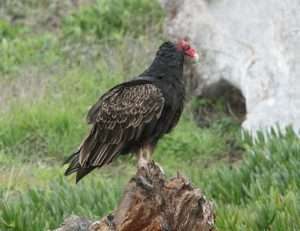 Name: Turkey Vulture (Cathartes aura)
Name: Turkey Vulture (Cathartes aura)
Range and typical habitat(s): Widespread from extreme southern Canada all the way through the entirety of South America; southern Canada and the northern half of the United States only host turkey vultures during breeding season, which then migrate south for the winter. Some subpopulations/subspecies are more migratory than others; for example, C. aura ssp. meriodinalis, which spends its summers in the western half of southern Canada and the United States, may migrate well into South America for the winter and is considered the most migratory of all turkey vultures.
Look for turkey vultures in big, open areas; meadows, fields and roadsides are common hangouts. And, of course, watch the sky! They are more tolerant of human activity than some other raptors, and so you may very well get a look while driving down the highway.
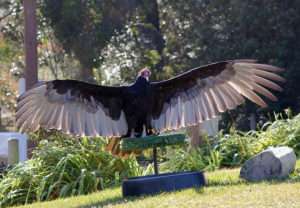 Distinguishing physical characteristics (size, colors, overall shapes, detail shapes): The turkey vulture is a large raptor which may stand almost three feet tall with a wingspan up to six feet across. Their body feathers are a very dark brown; the upper side of the flight feathers is a somewhat lighter brown with pale edges, and the undersides have a distinctively grayish tone. The turkey vulture gets its name from its bare head and upper neck, which in adults are a bright red with an ivory to very pale yellow beak; the legs are similarly pale. Juveniles are similarly colored except the head is grayish with a dark beak. Rare individuals display leucism; some or all of the feathers may be pale, with maybe a few smudges of light brown here and there.
Distinguishing physical characteristics (size, colors, overall shapes, detail shapes): The turkey vulture is a large raptor which may stand almost three feet tall with a wingspan up to six feet across. Their body feathers are a very dark brown; the upper side of the flight feathers is a somewhat lighter brown with pale edges, and the undersides have a distinctively grayish tone. The turkey vulture gets its name from its bare head and upper neck, which in adults are a bright red with an ivory to very pale yellow beak; the legs are similarly pale. Juveniles are similarly colored except the head is grayish with a dark beak. Rare individuals display leucism; some or all of the feathers may be pale, with maybe a few smudges of light brown here and there.

Like other raptors, the beak is hooked at the end and it has large, sharp claws on its feet. A close look at the beak reveals that the nostrils are perforate–that is, there is no septum between them, and you can look straight in one nostril and out the other.
When flying overhead, you can often see the tips of the primary wing feathers individually, rather like “fingers” at the ends of the wings. The long, slender tail is also longer than the feet, which are held trailing behind the bird rather than tucked up against the abdomen.
Behavior:
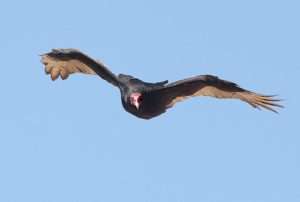 Vultures often soar on thermals, pockets of warm air that rise up from the ground. This efficient manner of flight allows them to survey large areas of land without tiring out. When flying, turkey vultures hold their wings in a distinctive “V” shape when viewed from the front or behind, making “V for vulture” a great way to recognize them even from a distance. They also teeter-totter side to side as they fly, another distinguishing characteristic. This video does a nice job of portraying their typical flight pattern. Conversely, they’re not greater movers on land and walk clumsily; it can also take some effort for them to take flight from the ground.
Vultures often soar on thermals, pockets of warm air that rise up from the ground. This efficient manner of flight allows them to survey large areas of land without tiring out. When flying, turkey vultures hold their wings in a distinctive “V” shape when viewed from the front or behind, making “V for vulture” a great way to recognize them even from a distance. They also teeter-totter side to side as they fly, another distinguishing characteristic. This video does a nice job of portraying their typical flight pattern. Conversely, they’re not greater movers on land and walk clumsily; it can also take some effort for them to take flight from the ground.
Despite cartoons and other caricatures that may portray vultures squawking menacingly, turkey vultures are quiet birds. Lacking the syrinx that allows other birds to vocalize, they are limited to rasping hisses and grunts.
Also, in spite of their reputation as fearsome or dirty animals, turkey vultures and their scavenger kin are an incredibly important part of their ecosystems. Okay, sure, the fact that they use projectile vomit when scared to help them fly away faster isn’t exactly endearing to most people, and in hot weather they poop on their feet to cool their blood and, by extension, their entire bodies. But their consumption of carrion help to prevent the spread of disease and distributes nutrients back into the food web more quickly. A bare head helps keep the vulture clean as it’s easier to remove blood and offal from skin than feathers. They may stand with their wings outstretched in the sun to kill off bacteria, and dry off and/or warm up in the process, too. And they preen just as much as any other bird!
 Turkey vultures are social birds, and often soar in groups known as “kettles”, which circle overhead on thermals. Once carrion is discovered, they descend as a group to feed. Food is detected by smell; most other raptors find their food by sight, so this is an unusual trait. A vulture may skim low along the ground in search of a whiff of “well seasoned” meat.
Turkey vultures are social birds, and often soar in groups known as “kettles”, which circle overhead on thermals. Once carrion is discovered, they descend as a group to feed. Food is detected by smell; most other raptors find their food by sight, so this is an unusual trait. A vulture may skim low along the ground in search of a whiff of “well seasoned” meat.
During breeding season, several adult turkey vultures may display on the ground by hopping in a circle together; a courting pair in flight will closely follow each other. The female lays two eggs, pale ivory or cream with brownish spots on the end; there’s usually no nest, just bare ground. Both parents will alternate incubation, and after about five to six weeks the chicks are born. Somewhere around two and a half months of age, they fledge, and the parents will take care of them until autumn.
Other organisms it could be confused with and how to tell the difference:
 Black vultures (Coragyps atratus) look similar at first glance, but as their name suggests their plumage is black, rather than brown. They are smaller and not quite as beefy in appearance, with their wingspan rarely exceeding five feet across. A black vulture only has pale feathers at the ends of the wings, and their tail is proportionately shorter than that of the turkey vulture. The bare head and neck are dark gray to black instead of red, the legs are similarly colored, and the beak is also dark and more slender than the turkey vulture’s. The black vulture also has bare skin further down the neck than on the turkey vulture. In flight they hold their wings flat instead of in a V, and they are steady soarers without the turkey vulture’s teeter-tottering flight pattern.
Black vultures (Coragyps atratus) look similar at first glance, but as their name suggests their plumage is black, rather than brown. They are smaller and not quite as beefy in appearance, with their wingspan rarely exceeding five feet across. A black vulture only has pale feathers at the ends of the wings, and their tail is proportionately shorter than that of the turkey vulture. The bare head and neck are dark gray to black instead of red, the legs are similarly colored, and the beak is also dark and more slender than the turkey vulture’s. The black vulture also has bare skin further down the neck than on the turkey vulture. In flight they hold their wings flat instead of in a V, and they are steady soarers without the turkey vulture’s teeter-tottering flight pattern.
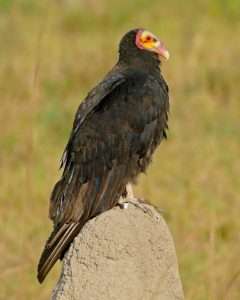
The South and Central American lesser yellow-headed vulture (Cathartes burrovianus) and greater yellow-headed vulture (Cathartes melambrotus) are the turkey vulture’s closest relatives. Both look quite similar to the turkey vulture, but have black plumage instead of brown. And as their common names suggest, both species have a distinctive yellow hue to their bare heads.
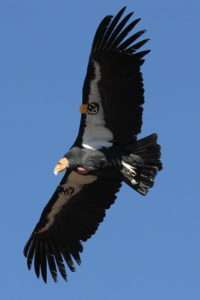
Should you ever be fortunate enough to see a California condor (Gymnogyps californianus) in the wild, it should be immediately apparent that this highly endangered vulture is much larger than a turkey vulture, with a wingspan upwards of ten feet across in the biggest individuals. Black instead of brown plumage, and long white patches on the underside of the condor’s wings, also set it apart. The Andean condor (Vultur gryphus) is also black and larger than a turkey vulture–its wingspan can reach almost eleven feet across–with a pronounced collar of white feathers around the neck

Turkey vultures may be mistaken for bald eagles (Haliaeetus leucocephalus) or golden eagles (Aquila chrysaetos), particularly at a distance. In flight, bald eagles have a flat wingspan instead of V-shaped, and do not teeter-totter (here’s a good comparison video); golden eagles may have a
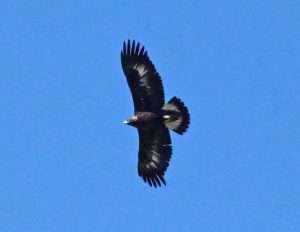
slight V to their wings, but are larger than turkey vultures, and also do not teeter-totter when they fly. Upon closer inspection, eagles have fully feathered heads. Golden eagles are primarily dark brown without the gray underside to the primary feathers, and a broad white band on the underside of the tail. Juvenile bald eagles are also brown but may have variable amounts of white feathers in their plumage; as adults, bald eagles have pure white heads and tails. Both eagles also have proportionately heavier beaks than turkey vultures, and their nostrils are divided by a septum rather than being hollow all the way through.

Ospreys (Pandion haliaetus) can look a bit like vultures at a distance if silhouetted or in poor lighting, but a better look reveals a lot of white plumage on the body and head. Some large hawks may also cause confusion, especially those with darker plumage like a Harris’ hawk (Parabuteo unciinctus), but other markings and distinctly feathered heads distinguish them. These birds also tend to be smaller than turkey vultures, have flat wingspans, and do not teeter-totter when flying.
Anything else worth mentioning?
Opinions vary as to whether vultures should be considered raptors/birds of prey. The “no” camp says that raptors should be primarily predatory as opposed to scavengers, while arguments for vultures-as-raptors hinge the debate on the fact that vultures, like other birds of prey, are primarily meat-eaters. I personally hold with the latter opinion myself, especially since eagles, hawks, and other “predators” are more than happy to scavenge when the opportunity arises. (And the Peregrine Fund, a nonprofit that works to conserve and protect raptors, also considers vultures to be birds of prey!)
Turkey vultures are not closely related to Old World vultures; both are an example of convergent evolution, where two distinct groups of living beings evolve similar traits independently. All New World (North and South American) vultures and condors are members of the family Cathartidae, while the Accipitridae are the Old World vultures found in Africa, Asia, and Europe. These latter birds find their carrion through sight, not smell.
Further reading:
Notes on the Taxonomy of Vultures
All About Birds: Turkey Vulture
10000 Things of the PNW: Turkey Vulture (Cathartes aura ssp. meridionalis)
The Peregrine Fund: Turkey Vulture
